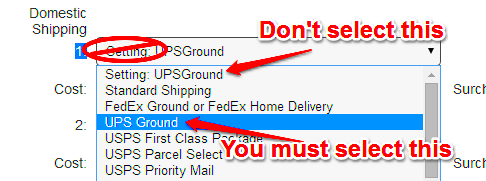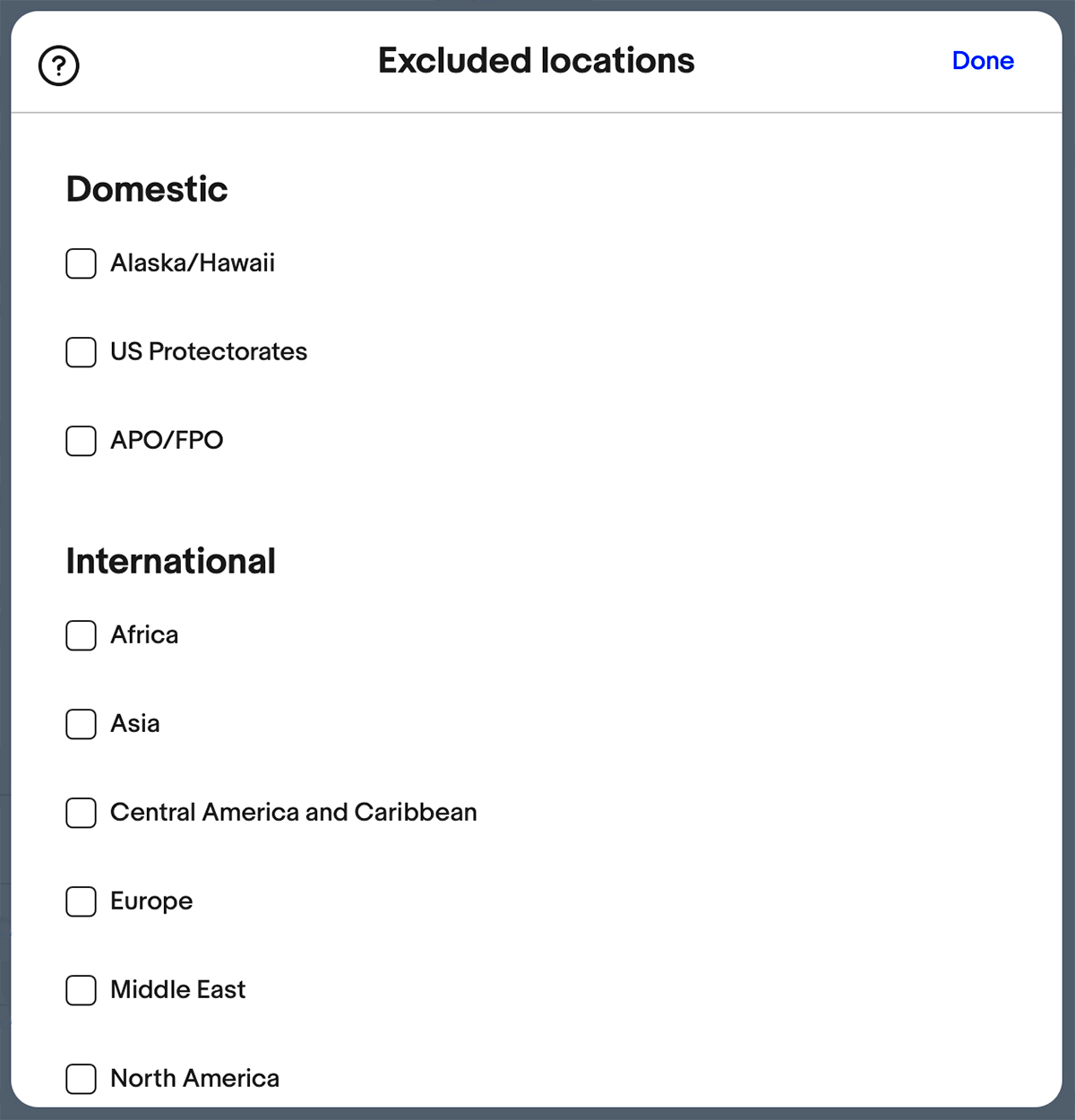Running an
eBay store involves a lot of moving parts, especially when it comes to managing your shipping settings. Getting these settings right is essential for keeping your business operations running smoothly and ensuring that your customers receive exactly what they expect.
eBay provides a variety of shipping options and grasping these choices can help you streamline your shipping process and steer clear of any potential hiccups.On
eBay you can customize your shipping preferences to determine how and where you send your products. This involves selecting carriers, establishing shipping rates and determining handling durations. It goes beyond simply transporting items from one location to another; it also entails controlling expenses offering delivery timelines and ensuring a positive customer experience.For example you can choose to provide shipping, a fixed rate for shipping or calculate the shipping costs based on the order details. Additionally you have the flexibility to establish different policies for shipping and international shipping allowing you to tailor your strategy according to the regions you operate in. This degree of personalization assists in meeting your unique business requirements whether you run a boutique or a major retail chain.Let’s say you have a little shop where you sell crafts that you make yourself. People in your area are familiar with how long it takes for their orders to arrive and how much it will cost. On the other hand sending packages overseas can be a bit unpredictable. If you take the time to understand and carefully choose your shipping options you can make sure that your business provides a reliable and enjoyable experience for all customers no matter where they are located.
Why You Might Want to Turn Off International Shipping

Disabling shipping to countries might appear to be a step but there are justifiable reasons behind it. Allow me to share an experience from my past. A while ago I encountered problems with orders that turned out to be more hassle than they were worth. Packages went missing customs fees were erratic and coordinating with buyers overseas became quite challenging. It was at that moment I understood that simplifying matters can often be the most effective approach.
Here are some reasons you might think about turning off shipping to other countries.
- Cost Management: International shipping can be significantly more expensive than domestic shipping. The added costs of international carriers and potential customs fees can eat into your profits.
- Complexity: Handling international orders often involves navigating different regulations, customs procedures, and potential language barriers. This complexity can lead to delays and increased customer service inquiries.
- Customer Experience: If international shipping isn’t managed well, it can lead to long delivery times, unexpected fees, and general dissatisfaction. If you’re unable to provide a smooth experience, it might be better to focus solely on your domestic market.
- Logistics Challenges: Shipping internationally requires careful handling to avoid issues like lost packages or damaged goods, which can be more frequent and harder to resolve compared to domestic shipping.
Ultimately disabling shipping can streamline your operations cut expenses and allow you to prioritize providing an improved experience for your customers.
How to Access Your eBay Shipping Settings

Changing your
eBay shipping settings is pretty simple, but it’s important to know where to look for the right options. If you’ve ever found
eBay’s interface a bit confusing like wandering through a maze you’re not the only one! However once you get used to it it gets a lot smoother.
Follow this guide to navigate to your shipping settings.
- Log into eBay: Start by logging into your eBay account with your credentials.
- Go to Account Settings: Hover over the “My eBay” tab at the top of the page and select “Account” from the drop-down menu.
- Select Shipping Preferences: In your account settings, look for the “Shipping” section and click on “Shipping Preferences.”
- Review and Modify Settings: Here, you can review your existing shipping options and make changes as needed. You can adjust shipping methods, set rates, and specify handling times.
- Save Changes: After making your adjustments, don’t forget to save your changes to ensure they are applied to your listings.
Imagine you have a sought after assortment of classic goods as a seller. It could be beneficial to tweak your shipping preferences to accommodate the specific needs of these items, like opting for packaging or extending handling times because of their fragility. By accessing and adjusting these settings you can streamline your shipping process making it more efficient and seamless. This ultimately enhances the overall experience for your customers.
Step-by-Step Guide to Turning Off International Shipping
If you're new to
eBay or haven't made changes to your shipping settings before turning off international shipping might feel a bit overwhelming. However once you get the hang of it it's actually a fairly simple process. A few years back I had to do this for my own store and let me tell you the relief I felt when everything was sorted out was absolutely worth it. So here's a guide to walk you through the steps.
- Sign In to Your eBay Account: Begin by logging into your eBay account. Make sure you’re using the account associated with your store or listings.
- Navigate to Your Account Settings: Hover over “My eBay” at the top of the page, then click on “Account” from the dropdown menu.
- Find the Shipping Settings: In the “Account” section, look for the “Shipping” tab and select “Shipping Preferences.” This will take you to the area where you can adjust your shipping settings.
- Edit Your Shipping Options: Locate the section labeled “International Shipping.” Here, you’ll see options related to shipping regions and methods.
- Turn Off International Shipping: To disable international shipping, uncheck the boxes or select options that exclude international destinations. This action prevents your listings from being available to buyers outside your selected regions.
- Save Your Changes: After making the necessary adjustments, click the “Save” button to apply the changes. This ensures that your new shipping settings take effect immediately.
Keep in mind that disabling shipping doesn’t prevent you from making changes down the road. You can always come back to these settings if you choose to broaden your shipping choices in the future. Its all about striking an equilibrium that suits your business needs.
What Happens When You Disable International Shipping
Shutting down shipping to other countries might feel like missing out on chances but there are times when it’s crucial for the well being of your business. I made this choice for my own store because I was overwhelmed with challenges that I wasn’t ready to tackle. Here’s what you can anticipate when you disable shipping.
- Reduced Scope: Your products will no longer be visible to international buyers. This means you might miss out on potential sales from overseas customers, but it also simplifies your shipping logistics.
- Lower Shipping Costs: By not offering international shipping, you avoid the high costs associated with international carriers, customs fees, and potential returns.
- Simplified Management: Managing orders from multiple countries can be complicated. By focusing only on domestic shipping, you reduce the risk of shipping errors, delays, and complicated customs processes.
- Potential for Local Focus: You can concentrate on catering to your local market more effectively, improving your service, and perhaps even offering more tailored products for local customers.
Essentially though putting a stop to shipping can simplify things for you it’s crucial to consider the trade off between the advantages and the possible decline in worldwide sales. Personally I saw it as a way to run my business smoothly and it yielded great results. You might discover that it’s also the right decision for your store.
How to Inform Your Buyers About Shipping Restrictions
When you make the decision to stop offering shipping, it’s essential to convey this update to your customers. There’s nothing more frustrating for a buyer than discovering at the checkout that you don’t deliver to their area. I learned this lesson through experience when a few disappointed international customers contacted me after being unable to finalize their orders. Here’s how you can ensure your customers stay in the loop:
- Update Your Listings: Clearly state your shipping policies in each product listing. You can include a note like “We currently only ship within [Country]” to avoid any confusion.
- Adjust Your Store Policies: Make sure your store policies reflect your shipping restrictions. Update the “Shipping” section of your store to include information about domestic-only shipping.
- Use eBay's Messaging Tools: If you have existing international buyers or are running an international promotion, use eBay’s messaging tools to notify them about the change in shipping policies.
- Provide Alternative Options: If you have partnerships with international resellers or third-party shipping services, consider sharing this information with potential international buyers who might still want your products.
Clear communication plays a role in nurturing customer relationships and preventing any annoyance. By implementing these measures I found the process to be more seamless and my clients valued the transparency. Putting in some initial work can significantly impact customer contentment.
Common Issues and Troubleshooting Tips
Managing an
eBay store is similar to nurturing a garden there are always a few weeds to deal with and unexpected challenges to handle. When it comes to shipping there are common problems that may initially feel like obstacles. I recall an incident where a shipment mix up nearly threw off my entire week. However addressing these issues directly with the approach can truly make a significant impact. Here are some common shipping problems and practical suggestions, to overcome them.
- Shipping Costs Not Calculating Correctly: Sometimes, shipping costs may not be calculated accurately. Double-check your shipping settings to ensure that weight, dimensions, and destination information are correctly entered. If you're using calculated shipping, verify that your postal codes and shipping rates are up to date.
- Delayed Deliveries: Delays can be frustrating, both for you and your buyers. To mitigate this, make sure your handling times are realistic and clearly communicated. Additionally, consider using reliable carriers and offering tracking numbers so customers can monitor their shipments.
- Lost or Damaged Packages: This is every seller's nightmare. Always pack items securely and use insurance or tracking options if available. If a package goes missing or is damaged, promptly contact the carrier to file a claim and keep your buyer informed throughout the process.
- Customs Issues: International shipments can face customs delays or unexpected fees. Clearly state on your listings that buyers are responsible for any customs charges, and provide them with information on what to expect when their packages reach their countries.
Dealing with these challenges calls for a balance of patience and proactive approach. Keeping yourself updated and tackling issues swiftly will ensure customer satisfaction and smooth operations for your business.
Reviewing and Updating Your Shipping Policies Regularly
Shipping policies are crucial for the smooth operation of your business much like a sturdy foundation supports a house. It’s important to regularly review and update your shipping policies just like you would with other aspects of your eBay store. Based on my experience overlooking these updates can cause confusion and result in missed chances. Here’s why it’s vital to conduct reviews regularly.
- Adapting to Changes: Shipping rates, carrier services, and international regulations can change frequently. Regular reviews help you stay updated with these changes and adjust your policies accordingly.
- Improving Efficiency: Periodically reviewing your policies allows you to identify any inefficiencies or areas for improvement. For example, you might discover that a different shipping method is more cost-effective or that adjusting your handling time can enhance customer satisfaction.
- Reflecting Business Growth: As your business grows, your shipping needs might evolve. Regular updates ensure that your policies align with your current business model and market strategy.
To stay on top of your shipping policies make it a habit to review them every few months or whenever there are significant updates. This not only helps you stay compliant but also ensures a smooth experience for your customers.
Common Issues and Troubleshooting Tips
Managing an eBay shop is similar to leading an orchestra; all the elements must work together seamlessly for the show to proceed flawlessly. Shipping plays a role in this orchestration and although most days things run like clockwork there are instances when things don't go as planned. Based on my experiences I can assure you that handling shipping challenges can be quite a hassle but having the right approach to tackle them can alleviate a significant amount of stress.
- Shipping Costs Not Adding Up: Sometimes, you might find that shipping costs on eBay don’t match what you expected. Double-check your shipping settings to ensure that weight, dimensions, and destination details are accurate. Additionally, make sure that any shipping calculators or third-party integrations are functioning correctly.
- Delayed Shipments: Delays can occur due to various reasons—be it weather, carrier issues, or incorrect address details. To minimize these, clearly state your handling times in your listings and use reliable carriers. Also, providing tracking information helps manage customer expectations.
- Lost or Damaged Items: Handling lost or damaged items can be frustrating. Always pack items securely and consider using insurance or tracking options. If an issue arises, promptly contact the carrier to resolve it and keep your customers informed about the status of their orders.
- Customs Complications: International orders can face customs hurdles that might delay delivery or lead to additional charges. To avoid this, inform buyers about potential customs fees and ensure that your listings clearly state that the buyer is responsible for these charges.
By taking a proactive approach and tackling these typical challenges directly you can ensure that your shipping processes run seamlessly and uphold a positive rapport with your clients.
Reviewing and Updating Your Shipping Policies Regularly
Your shipping policies play a role in the smooth functioning of your eBay stores logistics similar to how a machine requires routine upkeep. Through my experience as an eBay seller I've realized that regularly refreshing shipping policies is essential for seamless operations. It not only aids in handling shipments but also ensures that you're ready for any unforeseen changes that may arise.
- Adapt to Changes: Shipping costs, carrier options, and international regulations can shift. Regularly reviewing your shipping policies allows you to stay ahead of these changes and adjust your policies accordingly.
- Enhance Efficiency: Periodic updates can reveal areas where you can streamline processes or cut costs. For example, you might find a more cost-effective shipping method or discover that adjusting handling times could improve customer satisfaction.
- Reflect Business Growth: As your business evolves, your shipping needs will too. Regularly updating your policies ensures that they match your current business model, whether you’re expanding your product range or reaching more customers.
Regularly reviewing and refreshing your shipping policies will help your business stay flexible and adaptable to changes, leading to an improved experience for your customers.
FAQ About eBay Shipping Settings
Grasping how eBay handles its shipping settings can be a bit tricky. As someone who has gone through this process I have come across a lot of inquiries that sellers often have. So here’s a useful FAQ to help clarify some of the confusion and make sure your shipping settings are in order.
How can I change my shipping rates?
- To update your shipping rates, go to “Shipping Preferences” in your account settings. Here, you can adjust rates based on different regions and methods to better fit your needs.
Can I offer free shipping on just certain items?
- Absolutely! You can set free shipping for specific items by editing the listing and selecting “Free Shipping” under the shipping section. Make sure to check that this option is only applied to the items you choose.
What if I want to use multiple carriers?
- eBay allows you to select multiple carriers. Go to your shipping settings and add the carriers you prefer. This flexibility lets you offer different shipping options to meet various customer needs.
How should I handle international returns?
- For international returns, clearly outline your return policy in your listings. Make sure customers understand the process and any potential costs associated with returning items from abroad.
By tackling these questions that come up often you can make sure you handle your shipping preferences well and steer clear of typical mistakes.
Conclusion: Simplify Your Shipping Policy for Better Management
When it comes to selling on eBay having a shipping policy can really make a difference. By keeping things simple you can avoid complications, make your processes smoother and dedicate more time to expanding your business. Regularly checking and refreshing your policies helps you stay prepared for any challenges that may arise and ensures a seamless experience for your customers. Embracing simplicity will make it much easier and more efficient to handle your shipping.
 Disabling shipping to countries might appear to be a step but there are justifiable reasons behind it. Allow me to share an experience from my past. A while ago I encountered problems with orders that turned out to be more hassle than they were worth. Packages went missing customs fees were erratic and coordinating with buyers overseas became quite challenging. It was at that moment I understood that simplifying matters can often be the most effective approach.
Disabling shipping to countries might appear to be a step but there are justifiable reasons behind it. Allow me to share an experience from my past. A while ago I encountered problems with orders that turned out to be more hassle than they were worth. Packages went missing customs fees were erratic and coordinating with buyers overseas became quite challenging. It was at that moment I understood that simplifying matters can often be the most effective approach. Changing your eBay shipping settings is pretty simple, but it’s important to know where to look for the right options. If you’ve ever found eBay’s interface a bit confusing like wandering through a maze you’re not the only one! However once you get used to it it gets a lot smoother.
Changing your eBay shipping settings is pretty simple, but it’s important to know where to look for the right options. If you’ve ever found eBay’s interface a bit confusing like wandering through a maze you’re not the only one! However once you get used to it it gets a lot smoother.
 admin
admin








